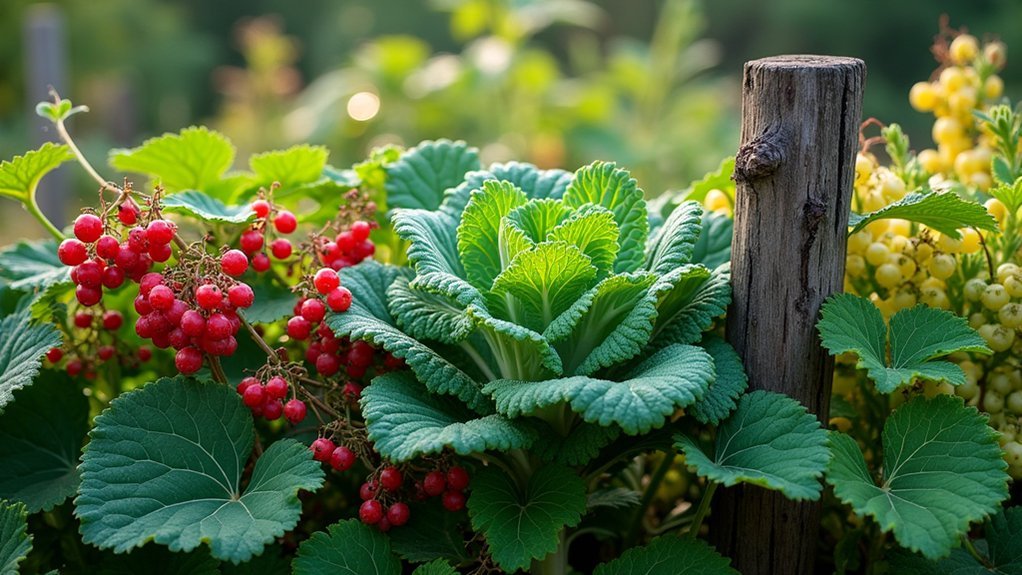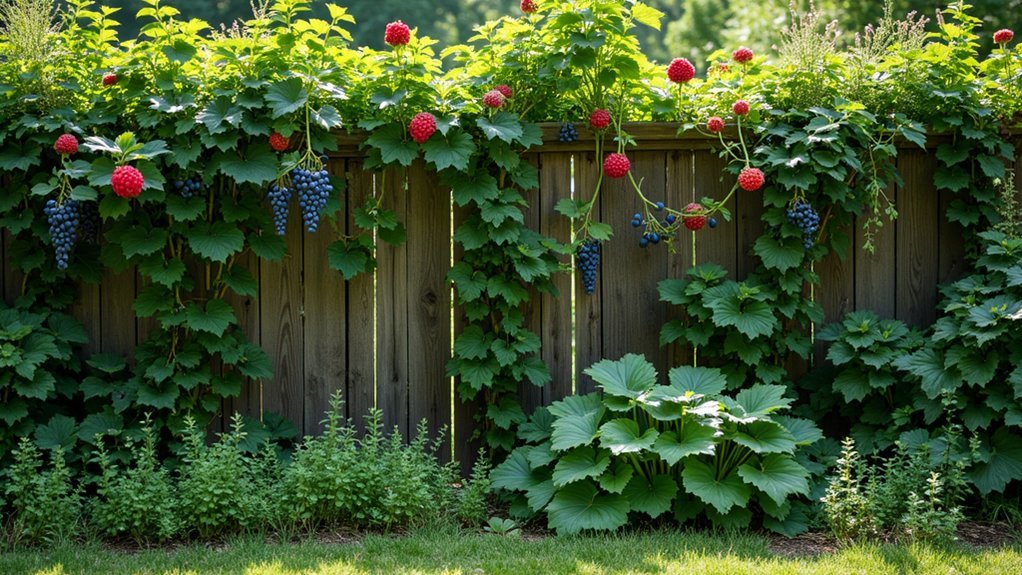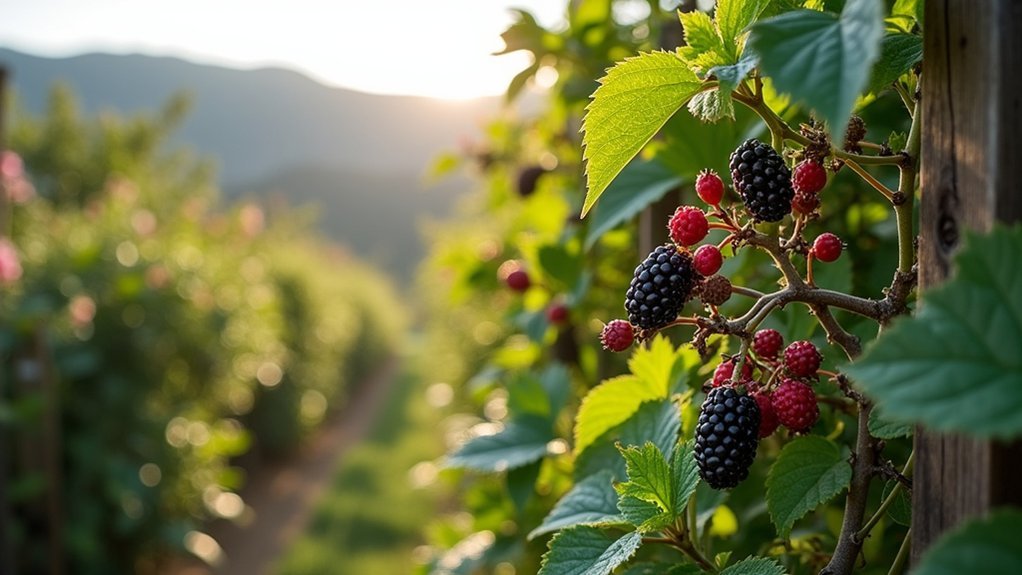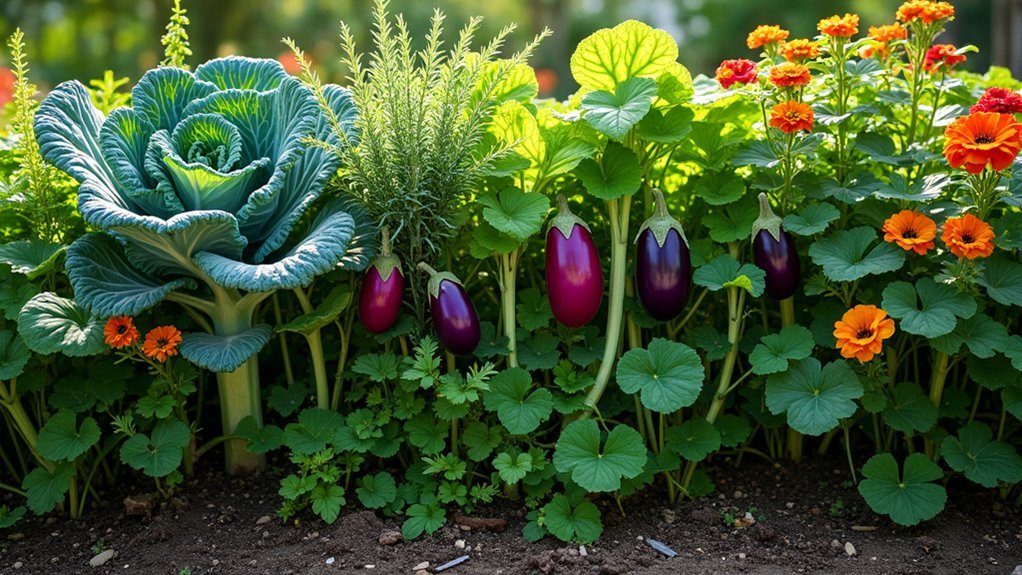Selecting the right edible fence plants depends on your hardiness zone. Cold regions (zones 3-5) thrive with cranberry bush, currants, and elderberries. For temperate zones 6-7, try raspberries, blackberries, and figs. Warm climates (zones 8-10) support citrus trees, tropical berries, and rosemary hedges. For security, thorny options like blackthorn or natal plum work well. Native species offer additional ecological benefits while providing seasonal harvests throughout the year. Your perfect edible boundary awaits below.
Understanding Plant Hardiness Zones for Edible Fence Selection

When planning an edible fence, your first step should be understanding plant hardiness zones. These zones, defined by average annual minimum temperatures, determine which plants will survive in your region. The USDA Hardiness Zone Map divides North America into numbered zones, with each number representing a 10-degree Fahrenheit difference in minimum temperatures.
Your zone’s specific conditions will guide your plant selections, but don’t rely solely on this information. Consider microclimates within your property, soil quality, sun exposure, and precipitation patterns. You can access the complete Hardiness Zones database through various gardening resources to make more informed decisions. These factors greatly impact plant health beyond basic cold tolerance.
For the most successful edible fence, combine hardiness zone information with local knowledge. You’ll need to account for seasonal variations and maintenance requirements when selecting plants that will thrive in your specific growing environment.
Cold-Hardy Edible Fence Options for Zones 3-5
Residents of zones 3-5 face unique challenges when creating edible fences, as winter temperatures can plummet well below zero.
Creating edible boundaries in northern climates requires careful selection of cold-hardy varieties that can withstand frigid winter conditions.
Fortunately, several plant varieties can withstand these harsh conditions while providing both food and privacy.
American Cranberry Bush (Viburnum trilobum) stands out as an excellent choice, growing 6-10 feet tall and producing edible berries even in zone 3.
Consider these robust options:
- Currants and gooseberries (Ribes spp.) thrive in zone 3 and offer tart fruits perfect for jams
- Hawthorn (Crataegus spp.) provides berries and creates dense barriers in zones 4-8
- Dog roses (Rosa canina) yield vitamin-rich rose hips in zone 5 and above
- Elderberries (Sambucus spp.) grow vigorously and produce versatile berries for syrups and wines
When planting these cold-hardy varieties, early spring after the final frost is the best planting time for successful establishment and growth.
Temperate Climate Edible Fences for Zones 6-7

Zones 6-7 offer ideal conditions for a diverse array of edible fence plants that thrive in temperate climates.
With winter lows ranging from -10°F to 10°F, you’ll need hardy species that can withstand cold winters while flourishing in warm summers.
Elderberry and currant make excellent hedge options, creating privacy while producing nutritious berries rich in antioxidants. Both thrive in zones 3-8, making them perfect for your temperate garden.
If you’re in Zone 7, consider adding figs for their fiber-rich fruits and attractive foliage, though they’ll need frost protection in Zone 6.
Raspberries provide vitamin C and create effective barriers when trained on supports. Blackberries also make excellent boundary plants as they prefer full sun and will produce abundantly along your fence line.
For acidic soil areas, cranberries work well in Zone 7.
Combine different species for year-round harvests and varied textures that enhance your landscape while serving as functional boundaries.
Warm Region Edible Barriers for Zones 8-10
Warm climates in zones 8-10 offer you exceptional opportunities to create living fences with citrus trees that form fragrant, fruit-bearing privacy screens throughout the year.
You’ll find tropical berries like natal plum and blackberry create impenetrable yet productive boundaries that serve dual purposes of security and food production.
Mediterranean herb fences featuring bay laurel and tea olive can transform your property line into an aromatic culinary resource that thrives in these sun-drenched regions. Rosemary forms an excellent drought-tolerant hedge reaching up to 6 feet tall and remains hardy down to zone 8.
Citrus Privacy Screens
While traditional fencing materials provide privacy, citrus trees offer a functional alternative that combines security with a bountiful harvest in USDA zones 8-10.
Several varieties thrive in these warmer climates—mandarins like ‘Tango’ create dense barriers while kumquats tolerate temperatures down to 18°F, making them suitable for zone 8’s cooler areas.
For ideal protection and fruit quality, consider these advantages:
- Protective screen systems (CUPS) using 50-mesh netting reduce sunburn and wind damage while excluding pests like Asian citrus psyllid
- Strategic placement on south or east sides maximizes light exposure while creating beneficial microclimates for understory plants
- Citrus windbreaks decrease water loss through evaporation and minimize fruit scarring
- Regular pruning maintains screen density and promotes healthy fruit production without compromising your privacy barrier
Modern citrus growers are experiencing higher yields of up to 800 boxes per acre when implementing protective screening systems.
Tropical Berry Boundaries
Transforming your property line into a lush, fruit-bearing barrier offers both privacy and seasonal harvests in warmer climates. In zones 8-10, you’ll find blackberries and raspberries particularly well-suited for creating edible boundaries.
Thorny blackberry varieties provide excellent security while producing abundant fruit. You can also opt for thornless cultivars if you prefer less prickly maintenance. Both require full sun to partial shade and well-drained, slightly acidic soil.
These vigorous plants need annual pruning to maintain their shape and promote fruiting. Train them along trellises or stakes to create defined pathways or garden dividers.
Blueberry varieties like the Silver Dollar offer sweet berries with distinctive pineapple flavor notes, making them an excellent addition to your edible fence.
Beyond their practical benefits, berry boundaries attract pollinators and birds, enhancing your garden’s biodiversity. They’ll also serve as effective noise buffers while providing you with fresh berries throughout the growing season.
Mediterranean Herb Fences
Creating a fragrant Mediterranean herb fence offers a perfect solution for zones 8-10 gardeners seeking both beauty and functionality.
These drought-tolerant plants provide privacy while supplying your kitchen with fresh culinary ingredients year-round.
Rosemary stands out as an exceptional choice, with varieties like ‘Tuscan Blue’ reaching heights of 6 feet to create dense, aromatic barriers.
You’ll find these herb fences not only practical but also aesthetically pleasing, contributing to a classic Mediterranean garden atmosphere. The Pineapple Guava complements Mediterranean plantings with its stunning bark and edible flowers.
- Bay trees offer hardiness with aromatic leaves perfect for soups and stews
- Mediterranean saltbush provides striking silvery foliage that can be shaped into formal hedges
- Herbs like rosemary naturally repel garden pests, reducing the need for pesticides
- Strategic placement can create distinct garden “rooms” while attracting beneficial pollinators
Designing Multi-Season Harvest Fences for Your Climate
Planning a successful edible fence requires careful consideration of your specific climate conditions and growing zone. Select plants that will thrive in your USDA zone while providing harvests throughout multiple seasons.
A thoughtful edible boundary starts with climate wisdom, choosing zone-appropriate plants for year-round harvests.
Elderberry makes an excellent foundation plant, offering spring flowers and late-summer berries with minimal maintenance. For zones 4-8, consider hazelnuts, which require full sun but tolerate poor soil once established. Supplement these with fruiting quince for additional seasonal harvests.
Incorporate perennial climbers like grapes for summer shade and winter light penetration. In warmer climates, lablab beans and scarlet runner beans can quickly cover fencing while producing edible pods. Passion fruit creates an evergreen privacy screen with its thick, lush foliage while producing delicious fruit. Bitter gourd thrives in drought-prone areas, while malabar spinach provides leafy greens during hot months when other vegetables struggle.
Regular pruning, especially for hazelnuts and grapes, guarantees continued productivity and maintains your fence’s structural integrity.
Security-Focused Thorny Edibles by Climate Zone

For homesteaders seeking both security and sustenance, thorny edible plants provide an ideal solution by creating a protective barrier while yielding valuable harvests.
Your climate zone greatly determines which security plants will thrive in your location.
- Warm Climates: Natal plum and bougainvillea offer excellent protection with their thorny structures, while pomegranate provides both security and delicious fruit.
- Cool Climates: Blackthorn and hawthorn create formidable barriers in cooler regions, with roses adding both beauty and protection. When planting, maintain 33cm spacing between each plant to establish an effective defensive hedge.
- Dry Areas: Eastern prickly pear and blackthorn demonstrate impressive drought tolerance while maintaining their defensive capabilities.
- Coastal Regions: Sea buckthorn thrives in salt-sprayed environments, while natal plum performs exceptionally well in warmer coastal zones.
Water-Wise Edible Fence Plants for Arid Zones
You’ll find several desert-hardy fruits like pomegranate and fig that create beautiful, functional fences while requiring minimal irrigation in arid zones.
Heat-loving hedge plants including prickly pear cactus and natal plum offer both security and edible harvests even in the hottest, driest conditions.
These water-wise choices establish strong root systems that thrive with deep, infrequent watering, making them perfect for regions where conservation matters most. Protect your edible fence plants from excessive wind exposure to help them retain soil moisture during extended drought periods.
Desert-Hardy Fruiting Options
Thriving in harsh conditions where other plants fail, desert-hardy fruiting plants offer an ingenious solution for creating edible fences in arid zones.
These resilient species provide both boundary definition and food production while requiring minimal water once established. Pomegranate trees are exceptional options that thrive in poor soils while producing nutritious fruits with minimal maintenance.
- Feijoa and Natal Plum make excellent hedge options—feijoa offers fire-retardant qualities, while the thornless varieties of Natal Plum produce cranberry-like fruits.
- Quince and Strawberry Guava thrive in full sun and drought conditions, perfect for preserves and fresh eating.
- Mulberry trees grow rapidly even in neglected spaces, providing quick shade and abundant fruit.
- Fig and Olive trees combine ornamental value with food production, creating edible boundaries that withstand intense heat.
Minimal Irrigation Choices
Water conservation becomes paramount when establishing edible boundaries in arid regions, making water-wise plant selection a smart investment for sustainable landscapes.
Herbs like rosemary, lavender, and oregano thrive with minimal irrigation while forming attractive, functional borders that deter pests.
For structural support, consider drought-tolerant vines such as passionfruit, grapes (especially ‘Mission’ variety), or nasturtiums that sprawl beautifully over fences.
Complement these with companion plantings like borage and calendula to improve soil moisture retention. Consider planting these close together to create a dense barrier that provides biointensive coverage for optimal water conservation.
Maximize efficiency by implementing drip irrigation, which reduces water usage by 30-50% compared to sprinklers.
Apply mulch to cut evaporation by 70% and group plants with similar water requirements.
Amending soil with compost greatly boosts water retention in sandy conditions, extending intervals between watering.
Heat-Loving Hedge Plants
Despite challenging conditions, arid zones offer perfect growing environments for numerous edible hedge plants that thrive in heat while requiring minimal irrigation.
You’ll find several versatile options that provide both privacy and food production with minimal maintenance.
- Pomegranate varieties excel in USDA Zones 7-10, developing into drought-resistant hedges that reward you with vibrant fruit once established.
- Manzanillo Fruiting Olive creates compact, evergreen barriers in zones 8-10, offering both aesthetic appeal and edible harvests.
- Rosemary serves as a fragrant, drought-tolerant hedge that provides culinary herbs while requiring only occasional pruning.
- Fig trees form excellent compact hedges that tolerate drought conditions, especially when given some protection, and need minimal pruning.
Consider incorporating mulberry trees into your edible fence design, as they offer self-seeding capabilities and exceptional drought and cold hardiness, particularly the white varieties.
Native Edible Fence Species for Regional Biodiversity
When you plant native species in your edible fence, you’re not just creating a functional boundary but also supporting the entire local ecosystem. Each region offers indigenous plants that thrive in local conditions while providing food.
North Americans can incorporate Arrowwood, Hazelnut, and Blackberry for both beauty and sustenance. A minimum width of 6 feet is recommended for these plantings to ensure proper growth and ecological benefits.
Europeans find Hawthorn, Blackthorn, and Sea Buckthorn well-adapted to their climate, offering berries and nuts.
In South America, consider Guava, Passionflower, and Chilean Guava with its unique strawberry-pineapple flavor.
Australasian gardens benefit from Kakadu Plum, Desert Lime, and Davidson’s Plum.
Beyond food production, these native hedges enhance biodiversity, provide wildlife habitat, regulate microclimates, improve soil health, and add natural beauty to your landscape—all while yielding delicious harvests.
Frequently Asked Questions
How Do Edible Fences Impact Property Values?
Edible fences boost your property value by 5-15%, sell homes 15% faster, and appeal to 68% of homebuyers. They’re financially smart too, with perennials like apple trees yielding substantial returns over decades.
Can Edible Fences Attract Unwanted Wildlife or Pests?
Yes, your edible fence can attract unwanted wildlife and pests. Overripe fruits draw rodents and insects, while berry bushes may invite deer. You’ll need regular harvesting and strategic barriers to manage these risks effectively.
Are Edible Fence Fruits Safe for Pets?
You’ll need to remove seeds, pits, and inedible parts from edible fence fruits before sharing with pets. Many fruits are safe in moderation, but always watch for adverse reactions and consult your vet.
How Quickly Can an Edible Fence Establish Privacy?
Fast-growing berries like raspberries provide partial privacy in 2-3 years, while moderate growers take 3-5 years. You’ll achieve quicker results with proper spacing, full sun exposure, and compost-enriched soil. Pruning enhances density faster.
Do Edible Fences Require Special Soil Amendments?
You’ll need to amend your soil based on what you’re planting. Most edibles prefer rich, well-drained soil with compost, while some like blueberries require acidic conditions with specific pH adjustments.
In Summary
You’ll find that edible fences offer the perfect blend of functionality and food production for your specific climate zone. By selecting plants suited to your region’s conditions, you’re creating living boundaries that provide harvests throughout the year while addressing security needs. Don’t forget to incorporate native species when possible—they’ll thrive with minimal care while supporting local ecosystems. Your edible fence will soon become your garden’s most productive feature.





Leave a Reply